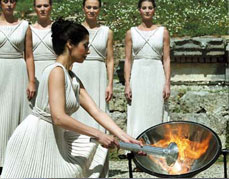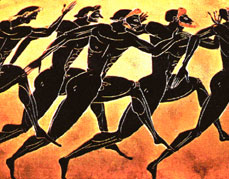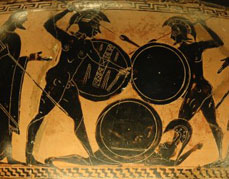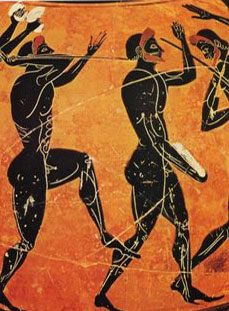
ATHLETIC CONTESTS
Inscriptions recording victors in the Panathenaic games of the Hellenistic period reflect a detailed and unvarying program for the athletic events. The contests for the boys came first. They competed in six events: three footraces, wrestling, boxing, and a combination of wrestling and boxing known as the pankration. Young men called ageneioi (not yet bearded) are listed next. They competed in one footrace, the pentathlon, wrestling, boxing, and the pankration. The men's division came last. In addition to the boys' and youths' events, it included two footraces, one of 80o meters (the hippios), the other of 400 meters in armor (the hoplites). Thus, the boys competed in six events, the young men in five, and the men in nine. Two of the premier events of the modern Olympics, the marathon run and the decathlon, are not attested in the ancient games.

FOOTRACES
Footracing was traditionally the oldest competition at Olympia (Pausanias 5.8.6), and we have very early evidence for it at Athens, too. The races were run on a straight track, such as the one in the middle of the Agora, so the runners had to round a turning post in any race longer than the zoo-meter sprint. An elaborate starting gate called the hysplex ensured that the runners started simultaneously, but the events themselves were not timed so we don't know the pace of ancient runners.In vase paintings we can determine, however, from the positions of the runners' arms, whether a long-distance race or a sprint is depicted.

HOPLITE RACE
With its military overtones, the race in armor was especially appropriate for the war goddess Athena and may have been introduced in Athens before its first appearance at Olympia (520 B.C.). Contestants, laden down with metal helmets and shields, were required to run two lengths of the stadium (400 m). On vases they can be distinguished from running warriors by the fact that they wear no body armor. In his comedy The Birds (291-292), Aristophanes compares the approaching chorus dressed as high-crested birds with the motley crew of armored runners in the hoplitodromos, thereby suggesting that there was something a bit comic about these clanking racers.

PENTATHLON
As its name implies, the pentathlon comprised five events: footrace, long jump, javelin, discus, and wrestling. It appears that one had to win outright three of the events to be the overall winner, but we know nothing about the details of the scoring, number of tries allowed, and so forth. Given the variety of skills needed to be a successful pentathlete, it is not surprising that Aristotle (Rhetoric 1361b) praised them for their physical appearance: "Pentathletes are the most beautiful; they are naturally adapted both for exertion of the body and swiftness of foot."
Unlike the barefoot runners, who required no special equipment, pentathletes had a variety of athletic apparatus. They used lead or stone jumping weights to improve the distance of their long jump, and a special leather throwing thong was attached to the javelin to enable the throw to be longer and more accurate. The circular discus was made of bronze, marble, or lead (15, 16); surviving examples vary considerably in size (r6-34 cm in diameter) and weight (1.25-6.6 kg, average 2.5 kg), but some of these may have been votive offerings and not intended for use in the games.

WRESTLING, BOXING, PANKRATION
Wrestling, boxing, and the pankration were known as the "heavy" events, perhaps because they were relatively brutal, or because there were no weight classes as exist today. As we see in vase paintings, those who took part were often large physical specimens. The famous philosopher Plato, whose name signifies broad shoulders, was known for his skill as a wrestler.
According to Greek legend, scientific wrestling was invented by the Athenian hero Theseus, best known as the slayer of the Cretan Minotaur. Wrestling was both part of the pentathlon and a separate event in its own right. The object of this competition was to win three falls out of a possible five, with a fall meaning a pin of the opponent's back, shoulders, or hips.
By today's standards Greek boxing was particularly savage, with blows being directed to the opponent's unprotected head rather than to his body. The fight went on until one of the boxers either was knocked out or admitted defeat by raising an index finger. There were no padded gloves; contestants merely wrapped their hands with light leather thongs and so, for all intents and purposes, were bare-knuckled. Heavily scarred and broken-nosed boxers are familiar figures in Greek art.
A combination of wrestling, boxing, and kicking, the pankration was probably the most violent event of the Panathenaea. Fingerbreaking, arm-twisting, choking, and blows to the genitals were not prohibited, although biting and gouging apparently were. As in boxing, the match ended when one contestant gave up or was incapacitated. The Athenian pankratist Kallias is the only periodonikes (winner at all four of the Panhellenic games) known from classical times. A monument base from the Acropolis records his wins at Olympia, the Panathenaia, Isthmia (five times), Nemea (four times), and Delphi (two times).
